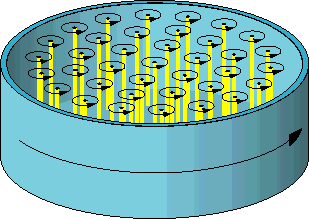
We are all familiar with vortices in fluids, for example, in a river when the water becomes turbulent after it has passed an obstacle, or in an emptying bath tube. A somewhat different case occurs in a glass of water that is placed on a rotating turn-table. After some initial slowness, the water starts to rotate uniformly with the glass. By definition, vorticity is also present in the uniform rotation because the flow velocity at the edges is larger than in the center.
There is a special class of fluids that are called superfluids. Superfluids have the property that they can flow through narrow channels without viscosity. However, more fundamental than the absence of dissipation is the behavior of superfluids under rotation. In contrast to the example of a glass of water above, the rotation in superfluids is always inhomogeneous (figure). The fluid circulates around quantized vortex lines. The vortex lines are shown as yellow in the figure, and the circulating flow around them is indicated by arrows. There is no vorticity outside of the lines because the velocity near each line is larger than further away. (In mathematical terms curl v = 0, where v(r) is the velocity field.)
The velocity around each vortex line is determined by h/m, where h is the Planck's constant, and m the mass of one atom. The presence of the Planck's constant means that quantized vorticity is a consequence of quantum mechanics. h is very small, but so is m, so the ratio h/m is quite macroscopic. Therefore, superfluidity is a quantum phenomenon on a macroscopic scale. The number of vortex lines depends on the constant h/m. There are approximately 1000 vortex lines in a container of radius 1 cm that is rotating 1 round per minute.
Superfluidity occurs only at low temperatures. The best known superfluids are the two isotopes of helium, 3He and 4He. Evidence of superfluidity has also been found in cold atomic gases. Related to superfluidity is superconductivity, which occurs in several metallic elements and compounds at low temperatures. Corresponding to the nonviscous flow in a superfluid, a superconductor can conduct resistanceless electric current. Vortex lines in a superfluid are analogous to flux lines which occur in a superconductor (of type II) when it is placed in a magnetic field. Superfluidity is also believed to occur inside neutron stars.
There are several different structures for vortices in superfluid 3He.
Back to helium theory page, to helium page
19.8.2003, Erkki Thuneberg, Email, Suomeksi